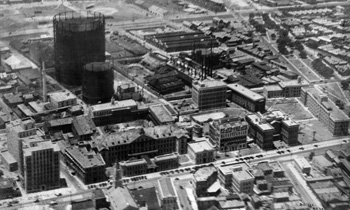|
The
Huey P. Long Years and Louisiana Politics
These years
also set the stage for the creation of the LSU School of Medicine.
In 1920 Dean Isadore Dyer died, and Charles Bass was appointed
dean in 1922. Frequently Bass did not see eye to eye with
the administrators of Charity hospital regarding staffing
and political decisions. In 1928, Huey P. Long, the “Kingfish,”
was elected governor of Louisiana. He promptly punished those
who had opposed him and rewarded his patrons by politicizing
the Charity Hospital administrative system. Some good did
come of this, however. In 1929, Bass and renowned Tulane internist
John Herr Mussner argued to Long that clinical teaching at
Charity was “absolutely rotten,” and that a separate
Tulane service was needed. Long approved this request, and
in July 1929 500 beds at Charity were assigned specifically
for the training purposes of Tulane School of Medicine.
In 1930, relations
between Charity and Tulane soured. Alton Ochsner, who would
later first publish the association between smoking and lung
cancer with Michael DeBakey, had come to Tulane in 1927 to
chair the Department of Surgery following Dr. Matas’
retirement. In a letter to another surgeon friend, Ochsner
wrote, “…the outlook at Tulane as far as building
up a department as concerned is absolutely hopeless. The university
is dependent upon Charity Hospital, a state institution which
is in the control of politics. The university is merely tolerated
in the hospital and there is no cooperation at all.”
Ochsner was also disturbed that Tulane had no say in appointing
residents to Charity; that was accomplished solely by the
hospital. A copy of this letter, under unknown circumstances,
eventually found its way into the hands of Huey Long. Long
promptly banned Ochsner from practicing at Charity for two
years.
Two other incidents fueled the fire between the governor,
Charity and Tulane. First, Long made no secret of his animosity
towards Tulane, predicated on Tulane’s denial of him
for a honorary doctor of laws degree he desired. Second, the
superintendent of Charity, Dr. Arthur Vidrine, wished to be
made chair of the otolaryngology department at Tulane School
of Medicine, in spite of no formal training in ear, nose,
and throat diseases. When Bass and Ochsner
refused, Vidrine likely passed on his disappointment and anger
to Long.
In December 1930,
a short three months after Ochsner had been dismissed from
Charity, Long announced that Louisiana State University would
have its own medical school that would open in 1931. He bragged
that “Honest boys with good records come out of LSU
and can’t get into that medical school… We’re
a-going to fix that.” In 1931 the LSU School of Medicine
opened its doors on the grounds of the Charity complex along
Tulane Avenue. Long appointed Vidrine the new president of
the school, and Vidrine promptly began to siphon off qualified
Tulane professors to teach at LSU. Dean Bass characterized
Vidrine as having a “brazen, defiant, dictatorial attitude.”
However, this animosity at the administrative level soon subsided.
Vidrine recruited the eminent New Orleans surgeon, Urban Maes,
to head LSU’s Department of Surgery, and Maes agreed
under the condition that Ochsner be reinstated. Huey Long
was assassinated in 1935, and Vidrine subsequently lost his
post as the powerful superintendent of Charity, retiring to
Ville Platte, Louisiana to start a small general medicine
practice.

prev | 1
| 2 | 3
| 4 | 5
| 6 | 7
| 8 | 9
| next |



